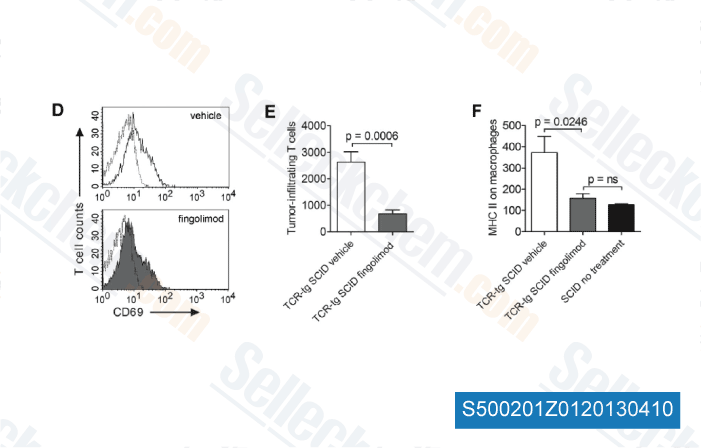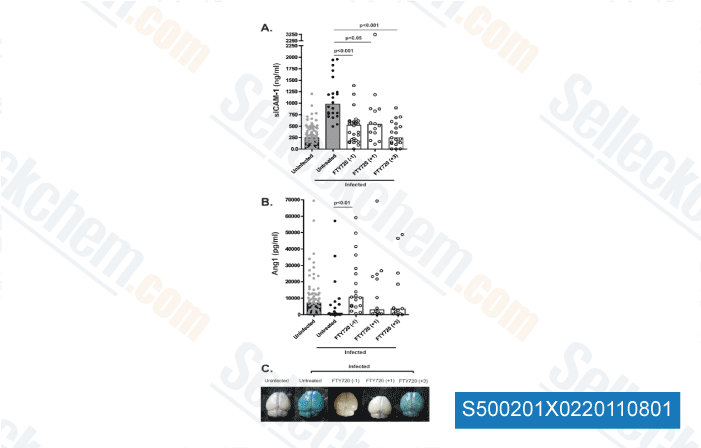|
Toll Free: (877) 796-6397 -- USA and Canada only -- |
Fax: +1-832-582-8590 Orders: +1-832-582-8158 |
Tech Support: +1-832-582-8158 Ext:3 Please provide your Order Number in the email. |
Technical Data
| Formula | C19H33NO2.HCl |
|||
| Molecular Weight | 343.9 | CAS No. | 162359-56-0 | |
| Solubility (25°C)* | In vitro | DMSO | 69 mg/mL (200.63 mM) | |
| Water | 69 mg/mL (200.63 mM) | |||
| Ethanol | 69 mg/mL (200.63 mM) | |||
|
* <1 mg/ml means slightly soluble or insoluble. * Please note that Selleck tests the solubility of all compounds in-house, and the actual solubility may differ slightly from published values. This is normal and is due to slight batch-to-batch variations. * Room temperature shipping (Stability testing shows this product can be shipped without any cooling measures.) |
||||
Preparing Stock Solutions
Biological Activity
| Description | Fingolimod (FTY720, Fingolimod Hydrochloride) HCl is a S1P antagonist with IC50 of 0.033 nM in K562, and NK cells. Please use saline solution rather than PBS for dilutions. PBS may cause precipitation. | ||
|---|---|---|---|
| Targets |
|
||
| In vitro | The inhibitory effect of S1P is revered by various concentrations of FTY720, with IC50 effect of 173 nM. In addition, FTY720 (10 nM) alone exerts no effect on the expression of co-stimulatory molecules. FTY720 reverses the increased expression of HLA-I induced by S1P for both the percentages of cells and the MFI, upon comparing the effect of S1P to the effect of combining S1P with FTY720. [1] Medium and high-dose FTY720-P also enhances the levels of TGF-β1. TGF-β1 and Foxp3 mRNA expression are upregulated in the high-dose FTY720-P group. The proliferation of effector T cells is suppressed significantly in the medium and high-dose FTY720-P group at a Treg/Teff cell ratio of 1:1. At a ratio of 1:1, the proliferation of effector T cells is also suppressed in the high-dose FTY720 group. [2] |
||
| In vivo | FTY720 is effective in Ph+ but not Ph- ALL xenografts using an early disease model. FTY720 produces a significant reduction in disease burden in the Ph+ ALL xenografts using an early disease model. Ph+ human ALL xenografts responds to FTY720 with an 80 % reduction in overall disease if treatment has been initiated early on. In contrast, treatment of mice with FTY720 does not result in reduced leukemia compared to controls using four separate human Ph- ALL xenografts. [3] |
Protocol (from reference)
| Cell Assay: |
|
|---|---|
| Animal Study: |
|
References
Customer Product Validation

-
Data from [Blood, 2012, 119, 2176-2177]

-
Data from [Blood, 2012, 119, 2176-2177]

-
Data from [Mol Med, 2011, 17, 717- 725 ]
Selleck's Fingolimod (FTY720) HCl has been cited by 141 publications
| S1PR1-biased activation drives the resolution of endothelial dysfunction-associated inflammatory diseases by maintaining endothelial integrity [ Nat Commun, 2025, 16(1):1826] | PubMed: 39979282 |
| Intratumoral delivery of lipid nanoparticle-formulated mRNA encoding IL-21, IL-7, and 4-1BBL induces systemic anti-tumor immunity [ Nat Commun, 2024, 15(1):10635] | PubMed: 39639025 |
| Anti-PD-1 therapy triggers Tfh cell-dependent IL-4 release to boost CD8 T cell responses in tumor-draining lymph nodes [ J Exp Med, 2024, 221(4)e20232104] | PubMed: 38417020 |
| A dual-STING-activating nanosystem expands cancer immunotherapeutic temporal window [ Cell Rep Med, 2024, S2666-3791(24)00544-5] | PubMed: 39454571 |
| SPHK1 promotes bladder cancer metastasis via PD-L2/c-Src/FAK signaling cascade [ Cell Death Dis, 2024, 15(9):678] | PubMed: 39284838 |
| FTY720 Reduces the Biomass of Biofilms in Pseudomonas aeruginosa in a Dose-Dependent Manner [ Antibiotics (Basel), 2024, 13(7)621] | PubMed: 39061303 |
| Restoring retinal polyunsaturated fatty acid balance and retina function by targeting ceramide in AdipoR1 deficient mice [ J Biol Chem, 2024, S0021-9258(24)01792-7] | PubMed: 38636661 |
| Germinal centers output clonally diverse plasma cell populations expressing high- and low-affinity antibodies [ Cell, 2023, 186(25):5486-5499.e13] | PubMed: 37951212 |
| Germinal centers output clonally diverse plasma cell populations expressing high- and low-affinity antibodies [ Cell, 2023, 10.1016/j.cell.2023.10.022] | PubMed: 37951212 |
| Low-dose radiotherapy combined with dual PD-L1 and VEGFA blockade elicits antitumor response in hepatocellular carcinoma mediated by activated intratumoral CD8+ exhausted-like T cells [ Nat Commun, 2023, 14(1):7709.] | PubMed: 38001101 |
RETURN POLICY
Selleck Chemical’s Unconditional Return Policy ensures a smooth online shopping experience for our customers. If you are in any way unsatisfied with your purchase, you may return any item(s) within 7 days of receiving it. In the event of product quality issues, either protocol related or product related problems, you may return any item(s) within 365 days from the original purchase date. Please follow the instructions below when returning products.
SHIPPING AND STORAGE
Selleck products are transported at room temperature. If you receive the product at room temperature, please rest assured, the Selleck Quality Inspection Department has conducted experiments to verify that the normal temperature placement of one month will not affect the biological activity of powder products. After collecting, please store the product according to the requirements described in the datasheet. Most Selleck products are stable under the recommended conditions.
NOT FOR HUMAN, VETERINARY DIAGNOSTIC OR THERAPEUTIC USE.
